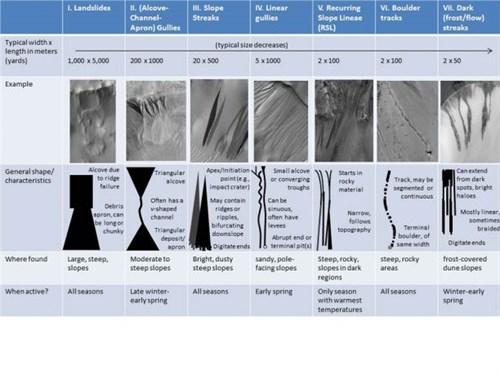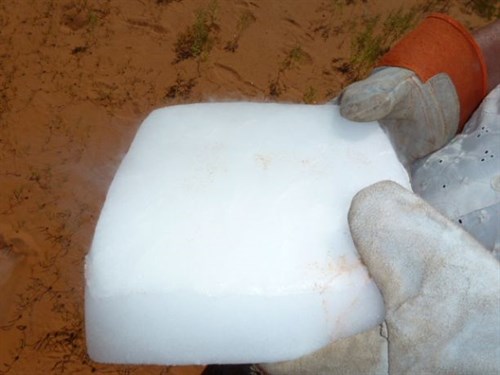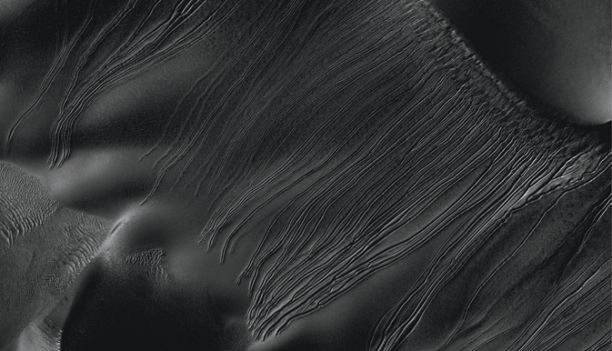By Guy Webster/JPL and Daniel Stolte/University Communications, June 11, 2013
NASA research indicates that hunks of frozen carbon dioxide – or dry ice – may glide down some Martian sand dunes on cushions of gas similar to miniature hovercraft, plowing furrows as they go.
Researchers deduced this process could explain one enigmatic class of gullies seen on Martian sand dunes by examining images from NASA's Mars Reconnaissance Orbiter, or MRO, and performing experiments on sand dunes in Utah and California.
As on the Earth, many processes can move material down a Martian slope. This graphic compares seven different types of features observed on Mars that appear to result from material flowing or sliding or rolling down slopes. (Illustration: NASA/JPL-Caltech/ASA/MSSS/UA)
"I have always dreamed of going to Mars," said Serina Diniega, a planetary scientist at NASA's Jet Propulsion Laboratory, or JPL, in Pasadena, Calif., and lead author of a report published online by the journal Icarus. "Now I dream of snowboarding down a Martian sand dune on a block of dry ice."
The hillside grooves on Mars, called linear gullies, show relatively constant width – up to a few yards or meters across – with raised banks or levees along the sides. Unlike gullies caused by water flows on Earth and possibly on Mars, they do not have aprons of debris at the downhill end of the gully. Instead, many have pits at the downhill end.
"In debris flows, you have water carrying sediment downhill, and the material eroded from the top is carried to the bottom and deposited as a fan-shaped apron," said Diniega. "In the linear gullies, you're not transporting material. You're carving out a groove, pushing material to the sides."
Images from MRO's High Resolution Imaging Science Experiment, or HiRISE, camera, operated by the University of Arizona, show sand dunes with linear gullies covered by carbon dioxide frost during the Martian winter. The location of the linear gullies is on dunes that spend the Martian winter covered by carbon dioxide frost. The grooves are formed during early spring, researchers determined by comparing before-and-after images from different seasons. Some images have even caught bright objects in the gullies.
Scientists theorize the bright objects are pieces of dry ice that have broken away from points higher on the slope. According to the new hypothesis, the pits could result from the blocks of dry ice completely sublimating away into carbon-dioxide gas after they have stopped traveling.
To test their hypothesis, the researchers purchased frozen carbon dioxide - dry-ice - and took it to a dune field. (Photo: Serina Diniega)
"Linear gullies don't look like gullies on Earth or other gullies on Mars, and this process wouldn't happen on Earth," said Diniega. "You don't get blocks of dry ice on Earth unless you go buy them."
That is exactly what report co-author Candice Hansen, of the Planetary Science Institute in Tucson, Ariz., did. Hansen has studied other effects of seasonal carbon-dioxide ice on Mars, such as spider-shaped features that result from explosive release of carbon-dioxide gas trapped beneath a sheet of dry ice as the underside of the sheet thaws in spring. She suspected a role for dry ice in forming linear gullies, so she bought some slabs of dry ice at a supermarket and slid them down sand dunes.
That day and in several later experiments, gaseous carbon dioxide from the thawing ice maintained a lubricating layer under the slab and also pushed sand aside into small levees as the slabs glided down even low-angle slopes.
The outdoor tests did not simulate Martian temperature and pressure, but calculations indicate the dry ice would act similarly in early Martian spring where the linear gullies form. Although water ice, too, can sublimate directly to gas under some Martian conditions, it would stay frozen at the temperatures at which these gullies form, the researchers calculate.
"We have seen blocks of ice sitting in the channels in our HiRISE images," said Alfred McEwen, a professor of planetary science at the UA who leads the HiRISE program who co-authored the paper. "Later, we saw them disappear by sublimation, in a matter of months."
Although the HiRISE camera doesn't allow researchers to measure the blocks' composition directly, McEwen said they behaved in the right way for carbon dioxide ice.
"Water ice block should be stable for much longer periods of time, and we know there is ample carbon dioxide in the area where those gullies are seen – in the higher latitudes of Mars' southern hemisphere."
"The origin of these linear gullies has been a mystery," McEwen added. "This study provides some direct clues as to how they are forming. The experiments using the dry ice show that our hypothesis is plausible."
Hansen also noted the process could be unique to the linear gullies described on Martian sand dunes.
"There are a variety of different types of features on Mars that sometimes get lumped together as 'gullies,' but they are formed by different processes," she said. "Just because this dry-ice hypothesis looks like a good explanation for one type doesn't mean it applies to others."
McEwen said the study adds an exciting new piece to growing series of discoveries about ongoing, active processes shaping the surface of the Red Planet.
"We are finding Mars is not Earth-like as it looks," he said. "Dry ice doesn't naturally exist here on Earth. MRO and the HiRISE instrument are healthy, and the longer the mission goes on, the longer we can observe and really understand these processes over the long term."
McEwen said the team is planning to continue to monitor these sites to see more ice blocks in action.
"We can't get any information from other instruments on the orbiter, because the features are too small," he explained. "But we are learning more about the distribution and latitude of those features and when they are active."
The UA's Lunar and Planetary Laboratory operates the HiRISE camera, which was built by Ball Aerospace & Technologies Corp. of Boulder, Colo. JPL manages MRO for NASA's Science Mission Directorate in Washington. Lockheed Martin Space Systems of Denver built the orbiter.













